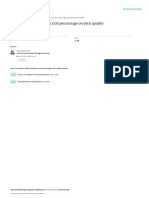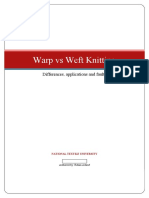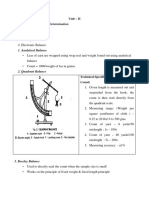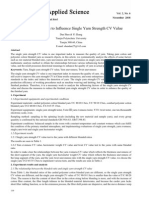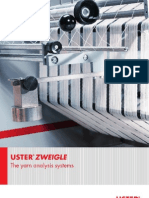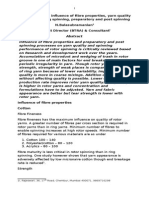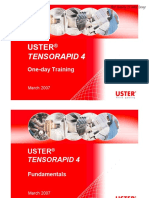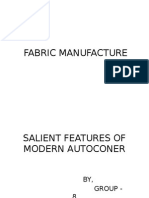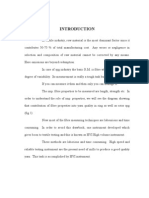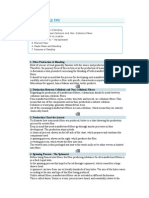Hairiness - I PDF
Hairiness - I PDF
Uploaded by
Durairaj.NCopyright:
Available Formats
Hairiness - I PDF
Hairiness - I PDF
Uploaded by
Durairaj.NOriginal Title
Copyright
Available Formats
Share this document
Did you find this document useful?
Is this content inappropriate?
Copyright:
Available Formats
Hairiness - I PDF
Hairiness - I PDF
Uploaded by
Durairaj.NCopyright:
Available Formats
Sevda Alta,
*Hseyin Kadolu
Ege University
Tire Kutsan M.Y.O.,
Textile Program,
35900, Tire, Izmir, Turkey
E- mail: sevda.altas@ege.edu.tr
*Ege University
Department of Textile Engineering,
35100, Bornova, Izmir, Turkey
E-mail: hkadoglu@textile.ege.edu.tr
Determining Fibre Properties and Linear
Density Effect on Cotton Yarn Hairiness
in Ring Spinning
Abstract
The hairiness of a yarn can be defined as the total number or total length of the fibres which
leave from the unit yarns surface. Yarn hairiness is formed by surface fibre edges which leave
the yarn center and spoil its appearance. Except for a few special cases, yarn hairiness is an
undesirable property in a yarn; an excessive degree of hairiness can cause serious problems
in both yarn production and in subsequent textile processes.
The aim of this study is to examine the effect of cotton fibre properties and linear density on
yarn hairiness. For this purpose, two different yarn counts were produced from 15 different
characterised cottons with the same process and machine parameters. Yarn hairiness was
tested with a Zweigle yarn hairiness meter. The fibre parameters were tested with HVI test
equipment. The fibre parameters and yarn hairiness results were analysed with the help of
the SPSS and MINITAB statistical pocket programs. We basically used multiple regression
analysis method for our test results. Among all the parameters examined in this study, yarn
linear density is the most important parameter affecting yarn hairiness. An increase in yarn
linear density increases the hairiness. Secondly, fibre length is also another important parameter which influences hairiness. The increase in fibre length decreases hairiness.
Key words: cotton yarn hairiness, regression analysis, Zweigle yarn hairiness tester, HVI
test machine.
cepted that a certain level of hairiness in
yarn is unavoidable, owing to the practical limitations of mechanical processing
machines [1].
Spinners are therefore interested in
knowing the effect of fibre properties
on yarn hairiness for the selection of
a suitable raw material. According to
previous research, fineness has the maximum effect on yarn hairiness among the
fibre properties, followed by fibre length,
whereas maturity contributes very little
towards hairiness. Fineness, length and
long-fibre percentage jointly influence
the formation of yarn hairiness to a considerable extent. An interesting finding is
that the independent relationship of longfibre percentage with yarn hairiness is
significant, whereas short- and mediumfibre percentages are not significant [2].
n Introduction
Yarn hairiness is a quite complex parameter of yarn quality that is affected
by various parameters. Many researchers have devoted their attention to the
influence of fibre parameters on yarn
hairiness. These results sometimes differ because of the nature of different
measuring principles. It is generally ac-
48
Barella was one of the first researchers
into yarn hairiness who introduced a
new technique in hairiness measurement,
based on counting the number of the fibres and their diameters as well as yarn.
Barella classified hairiness as protruding
fibre ends, the looped fibres and wild
fibres on the basis of the research done
by Morton &Yen into fibre migration in
cotton worsted and spun rayon yarn. He
also studied the various causes of yarn
hairiness by only changing the yarn twist
value. He found that the number of the
fibre ends on the yarn surface remained
constant when yarn twist was increased
in cotton yarns [3].
Barella and Manich manufactured cotton spun yarns from 34 staple stocks by
means of the ring spinning (34 yarns)
and rotor spinning (29 yarns) processes,
and tested the hairiness of these yarns
with a Shirley hairiness meter. For each
spinning system, yarns were produced at
two values of yarn linear density, but the
twist multiplier was kept constant within
the series for each spinning process. The
results showed that the hairiness of ring
spun yarns was higher than that of rotor
yarns. They also found that fibre length
and its uniformity have the greatest influence on hairiness for both ring- and rotorspun yarns, and fibre fineness has only a
slight influence on the yarn hairiness of
ring-spun yarns [4].
Pillay et al. carried out a comparative
study into the structure of rotor- and ringspun yarns from cotton and man-made
fibres. They showed that the effective
length of the fibres in yarn, as represented by the fibre spinning coefficient,
is significantly lower in OE yarns than in
ring yarns. They found that in OE yarns,
fibres migrate in a different way, and the
mean fibre position and amplitude of
migration are lower than those in conventional ring yarns [5].
Viswanathan et al. examined the influence of fibre characteristics on the hairiness of cotton yarns. They found that
fineness has the maximum effect on yarn
hairiness, followed by fibre length. There
is an independent relationship between
FIBRES & TEXTILES in Eastern Europe July / September 2006, Vol. 14, No. 3 (57)
Table 1. Experimental plan.
Machines brand/ model
Left,
tex
*Rieter/G 30 ring yarn machine
1st yarn
37
2nd yarn
16
Ingolstadt / F 4301
500
roving machine
Trtzschler / HSR 1000
2,300
II. drawframe machine
Dubbing
Draft
ratio
Drafting distance
of front-main draft
region, mm
Production
speed
1
1
14.54
32.72
71 - 48
14,000 rpm
14,000 rpm
4.4
76 - 52
800 rpm
50 - 41
300 metres/min
For a comprehensive examination of
yarn hairiness, the following hairiness
parameters should be available; (i.) total
number of hairs per unit yarn length, (ii.)
total length of hairs per unit, (iii.) the
length and number of hairs longer than
or equal to 3 mm per unit length. The
Zweigle yarn hairiness meter serves this
purpose well. We tested the yarns with
this machine and determined the number of hairs for different length classes
including 1, 2, 3, 4, 6, 8, 10, 12, 15, 18,
21, 25 mm, as well as the S3 code, which
defines the total number of hairs 3 mm
and above hair lengths.
* In the ring spinning machine, an Orbit type 42 mm ring and SFB 2.8 PM dr white-coloured
and chrome-coated travellers were used.
long fibre percentage and yarn hairiness,
whereas those of short- and medium-fibre percentages are not significant. [6].
Hequet and Ethridge determined the effect of cotton fibre length distribution on
yarn quality. For the carded ring-spun
yarns, their results showed that the shortest and the longest fibres exhibited the
highest correlation with the yarn evenness (CV%), the number of thin places,
and the number of thick places. For the
combed ring-spun yarns and rotor yarns,
the longest fibres exhibited the highest correlation with the yarn evenness
(CV%), thin places and thick places.
The shortest and the longest fibres are
highly correlated with the hairiness for
all types of yarns. The shortest fibres increase hairiness, while the longest fibres
decrease it [7].
n Materials and methods
This study is focused on the effect of
fibre parameters on cotton yarn hairiness.
For this purpose, two different carded
yarn counts were spun from 15 different
raw materials which were supplied from
different textile mills in sliver form. In
the roving machine, 0.5 ktex count and
42 T/m rovings were obtained from all
the draw frame bands. These rovings
were then spun with conventional ring
machines. We used identical machine
conditions for both the roving and yarn
production processes in order to eliminate the effect of these parameters on
hairiness. The experimental part of the
work described in this article was carried
out in Ege Universitys Textile & Apparel Research and Application Centre.
Table 1 shows the experimental plan of
the study.
The results obtained from the laboratory
testing of fibre and yarn samples were
evaluated by using the SPSS statistical
program. We basically used the multiple regressing analysis method with the
significance level of =0.05 for our test
results. All multiple regression analyses
were carried out for both yarn counts
together and separately.
To select the best model for regression
analysis, we used MINITAB and chose
the best model according to their corrected R2 values. Mostly, the best model
which was selected for analysis had the
highest corrected R2 value [8].
The fibre length, micronaire, uniformity
ratio, strength, short fibre index, elongation, trash count, brightness and yellowness parameters of each cotton samples
were tested with an HVI test machine.
n Results and discussion
The measurement results of the fibre
properties used in our statistical analysis
Table 2. Fibre properties results.
Measured fibre properties
Yarn properties composed of raw material with the following denotations (code)
P1
P2
P3
P4
P5
P6
P7
P8
P9
P10
P11
P12
P13
P14
4.5
3.8
3.9
4.2
4.2
4.3
3.8
4.1
4.3
4.3
4.1
4.3
3.4
4.4
4.2
Fibre strength,
35.8
30.8
30.8
30.4
29.3
35.6
47.0
29.2
33.5
33.9
31.7
31.6
30.1
31.9
31.8
2.5% span length, mm
29.0
29.9
29.2
29.9
29.9
28.9
34.0
29.9
30.9
29.3
28.0
29.9
29.9
31.2
31.5
Uniformity, %
87.4
86.4
83.9
86.6
85.4
83.7
86.8
86.1
88.2
85.9
84.9
85.9
82.9
87.3
87.2
Short fibre percentage, %
3.5
3.5
5.4
3.5
3.6
5.8
3.5
3.5
3.5
4.3
4.9
3.5
6.3
3.5
3.5
Elongation at break, %
7.8
8.4
8.7
8.6
7.6
8.1
8.0
8.9
7.4
8.0
8.8
8.7
8.4
8.1
7.7
Trash quantity
P1
P2
P14
P15
Fibre fineness, micronaire
P15
Table 3. Hairiness results.
Hairiness for
hair length
1 mm
2 mm
3 mm
S3
Linear
density, tex
Hairiness of yarn composed of raw material with the following denotations (code)
P3
P4
P5
P6
P7
P8
P9
P10
P11
P12
P13
37
12595 11844 14474 13569 14160 14104
16
9941 11058 11455 11020 13156 10862
8654 10980 12940 11551 13685
9791
9937
37
1070
1079
1544
1383
1601
1250
800
1266
1005
1310
1540
1023
1316
1562
1162
16
1050
1115
1197
1212
1538
1181
778
1281
822
1179
1504
1254
1264
1150
944
37
519
481
643
545
599
563
230
513
490
632
740
388
540
610
464
16
382
340
325
368
483
361
202
395
267
371
445
384
366
390
293
37
1421
1067
1209
1101
1184
1423
420
1139
1317
1621
1668
826
1147
1081
944
16
632
585
535
621
760
652
293
788
486
713
794
641
659
736
515
FIBRES & TEXTILES in Eastern Europe July / September 2006, Vol. 14, No. 3 (57)
9880 12399 11977 14297 14794 12052 14252 13070 11875
8884 11934
49
Figure 1. The number of 1-mm hair lengths.
Figure 2. The number of 2-mm hair lengths.
Figure 3. The number of 3-mm hair lengths.
Figure 4. The number of S3 codes.
- fibre fineness, fibre strength, 2.5% span
length, uniformity, short fibre percentage, breaking elongation and trash count
- are given in Table 2.
Generally, the correlation between yarn
parameters and hairiness factors are not
calculated for every single millimetre
of the fibre length (from 1 mm up to
10 mm), as these cause very divergent
results. According to the previous researches on yarn hairiness, there are
two different approaches for the length
of hairs which cause problems in yarn
and fabric production. The first approach
claims that hair lengths of 3 mm and
shorter are important [4, 5, 7]; while
the other states that the total number of
3 mm and longer lengths (S3 code) of
fibres caused hairiness [9, 10, 11]. In this
study, we evaluated the hairiness results
according to 1, 2, 3 mm hair lengths and
S3 codes together. The number of 1, 2
and 3 mm hair lengths and the value of
S3 codes are given in Table 3.
50
Each parameter experimented in this
study is explained below;
Linear density effect: Yarn linear
density is statistically significant when
evaluating both yarn counts together with
SPSS. We found a direct relationship between yarn linear density and hairiness;
the hairiness increases when the yarn
linear density increases. In other words,
coarse yarns have more hairs than fine
yarns for all the observed hair lengths.
This can be explained by the increase of
fibres in the cross-section of yarn. The
numbers of 1, 2 and 3 mm hairs and the
values of S3 codes for all yarn samples
are given in Figures 1 - 4.
Length effect: When 37 tex and 16 tex
yarns were evaluated together, except for
2 mm hair length, fibre length was found
to be statistically significant. When we
examine the effect of fibre length on
hairiness for two yarn counts separately,
the results are different. While in 37 tex
yarns fibre length is found to be statistically significant for S3 codes only, in
16 tex yarns it is found to be statistically
significant for 1, 2, 3 hair lengths and S3
codes. According to these results, we can
say that fibre length property is more
important in fine yarns than in coarser
yarns. Yarn hairiness decreases as the
fibre length increases.
Fineness effect: Fibre fineness property
is found statistically significant for 2 and
3 mm hair lengths when evaluating two
yarn counts together. Evaluating the effect of fineness for 37 tex and 16 tex separately, as for fibre length, we found that
the results differed. While in 37 tex yarns
fineness is statistically significant for
1 mm hair length only, in 16 tex yarns,
it is found to be statistically significant
for 2, 3 mm hair lengths and S3 codes.
According to these results, we can say
that fibre fineness is a much more important parameter in fine yarns than in
coarse yarns. Yarn hairiness increases as
FIBRES & TEXTILES in Eastern Europe July / September 2006, Vol. 14, No. 3 (57)
1 mm hair length
37 tex
16 tex
X
X
X
X
2 mm hair length
X
1 mm hair length
2 mm hair length
3 mm hair length
S3 code
Strength effect: Fibre strength is statistically significant for 2 mm hair length
only when evaluating two yarn counts
together. Evaluating the effect of fineness
for 37 tex and 16 tex separately, the results are nearly the same. In 37 tex, fibre
strength is found statistically significant
for 2 and 3 mm hair lengths. In 16 tex,
fibre strength is statistically significant
for 1 and 3 mm hair lengths. The increase
in fibre strength decreases yarn hairiness.
In addition to this, we found that fibre
strength is more important on shorter
hairs below 3 mm in length.
Uniformity effect: Uniformity is found
to be statistically significant for S3 codes
only when evaluating two yarn counts together. In 37 tex yarns, uniformity is also
statistically significant for S3 codes only.
However in 16 tex yarns, the uniformity
is statistically significant for 1 mm hair
length only. According to these results,
we can say that uniformity is mostly effective for hairs above 3 mm in length.
The increase in uniformity index value
increases hairiness. This relationship is
unexpected, according to the uniformity
measuring principle.
Short-fibre percentage: Short-fibre
percentage is statistically significant for
1 mm hair length and S3 code when
evaluating both 37 tex and 16 tex yarns
together. Evaluating the effect of shortfibre percentages in 37 tex and 16 tex
X
X
S3 code
X
X
3 mm hair length
the fibre fineness value (micronaire) increases due to high flexural and torsional
rigidities.
Trash count
S3 code
Breaking elongation
3 mm hair length
Short fibre percentage
Uniformity
2 mm hair length
Fibre strength
1 mm hair length
Measured
hair lengths
Fibre fineness
37 tex & 16 tex
2.5% Span length
Linear density
of the analysed
yarns
Yarn linear density
Table 4. The important experiment parameters which affect hairiness, marked with X.
X
X
separately, the results are very different.
While in 37 tex yarns the short-fibre percentage is statistically significant for 1, 2,
3 mm hair lengths and S3 codes, in 16
tex yarn it is statistically significant only
for 2 mm hair length. The increase in the
short-fibre percentage increase hairiness. Examining these results it can be
concluded that the short-fibre percentage
plays a more vital role in coarse yarns
than fine yarns.
Breaking elongation: Breaking elongation is statistically significant only in
37 tex when evaluating these yarns separately. The increase in breaking elongation decreases hairiness. According to
these results, breaking elongation is more
important for hairs above 3 mm in length,
especially in coarse yarns.
Trash quantity: Trash quantity is statistically significant for 1 mm hair length
in 37 tex yarns and 2 mm hair length in
16 tex yarns when evaluating yarns separately. Analysing these results, we can
say that trash quantity has no important
effect on yarn hairiness.
n Summary and conclusions
The aim of this study was to examine
the effect of cotton fibre properties and
linear density on yarn hairiness. For
this purpose, two different yarn counts
were produced from 15 different characterised cottons with the same process
and machine parameters. Yarn hairiness
was tested with a Zweigle yarn hairiness
meter. The fibre parameters and yarn
FIBRES & TEXTILES in Eastern Europe July / September 2006, Vol. 14, No. 3 (57)
hairiness results were analysed with the
help of the SPSS and MINITAB statistical pocket programs. We basically used a
multiple regression analysis method for
our test results with a significance level
of =0.05. Considering our experimental
measurements and statistical analysis, we
can summarise the results of this study as
follows (Table 4);
n Among all the parameters considered
in this study, yarn linear density is the
most important parameter that affects
the hairiness. Hairiness increases
when the yarn linear density increases.
n Among all raw material parameters,
fibre length is the most important fibre property that affects the hairiness.
The increase in fibre length decreases
hairiness.
n Fibre fineness property is more important for 16 tex yarns; on the other
hand, the short-fibre percentage plays
a vital role for 37 tex yarns hairiness.
n In addition to these results, we did
not observe any direct relationship
between trash count parameters and
yarn hairiness.
Acknowledgments
This work was supported and sponsored
by TUBITAK Textile Research Centre. The
production of yarns and their hairiness tests
were carried out at Ege Universitys Textile
& Apparel Research and Application Centre. The cotton fibre samples were tested
at Gbirlii Textile Yarn Mill. The authors
are grateful to these organisations for their
valuable assistance.
References
1. Datye K.V., Bose C.: The Indian Textile
Journal, 1981, August, p. 91-93.
2. Barella A.: Textile Progress, Vol. 24, No 3,
1993, p. 17.
3. Barella A.: Textile Progress, Vol. 13,
No. 1, 1983, p. 1.
4. Barella A., Manich A. M.: Journal of the
Textile Institute, 1988, vol. 79, No.2,
p. 189-197.
5. Pillay, K. P. R., Shankaranarayana, K. S.:
Proceedings of the Nineteenth Technological Conference, Ahmedabad Textile
Industrys Research Association, India,
1979, Vol. 1, p. 37-46.
6. zipek B.: Textile Month, 1999, January,
p. 29-34
7. Hequet E., Ethridge D., Beltwide Cotton
Conference, National Cotton Council,
Memphis, 2000, Vol. 2, p. 1507-1514
8. Alta S.: M. Sc. Thesis, The Institute of
Natural and Applied Sciences, Ege University, zmir, Turkey, 2005, February.
9. Wang X., Chang L.: Textile Research
Journal, 1999, Vol. 69 (1), p. 25-29.
10. Wang, X., Miao, M., Textile Research
Journal, 1997, Vol. 67 (7), p. 481-485.
11. Jeon B.S.: Textile Research Journal,
2000, Vol. 70 (11), p. 1019-1024.
Received 16.07.2005
Reviewed 19.02.2006
51
You might also like
- Modern Cotton Spinning Machinery, Its Principles and ConstructionFrom EverandModern Cotton Spinning Machinery, Its Principles and ConstructionNo ratings yet
- Advanced Fabric Structure PDFDocument35 pagesAdvanced Fabric Structure PDFManoj Mondal83% (6)
- yARN TWIST ANGLEDocument8 pagesyARN TWIST ANGLESabeeh Ul Hassan100% (1)
- Analysis of The Imperfection Index (Ipi) Value of Carded Yarn Produced by Using Different Diameter Spacers On The Ring Frame Spinning MachineDocument7 pagesAnalysis of The Imperfection Index (Ipi) Value of Carded Yarn Produced by Using Different Diameter Spacers On The Ring Frame Spinning MachineUtsho ParvezNo ratings yet
- Fibre MigrationDocument5 pagesFibre MigrationAbd. Alim100% (1)
- Unit 2Document76 pagesUnit 2Vaibhav SinglaNo ratings yet
- Fundamentals of Textile Machines and ProcessesDocument75 pagesFundamentals of Textile Machines and ProcessesAbi NikilNo ratings yet
- Melange YarnDocument11 pagesMelange YarnMd Ariful IslamNo ratings yet
- To Study Effect of Comber Noil Percentage On Yarn Quality: ArticleDocument12 pagesTo Study Effect of Comber Noil Percentage On Yarn Quality: Articlelalit kashyapNo ratings yet
- Warp Vs Weft KnittingDocument5 pagesWarp Vs Weft KnittingLinh NguyenNo ratings yet
- Unit - IiDocument27 pagesUnit - IiJoseph KuruvilaNo ratings yet
- 1.all Drafting System. All Parts of DraftingDocument3 pages1.all Drafting System. All Parts of DraftingRatul Hasan0% (1)
- Yarn Lea Strength Tester:: Prepared By-S. M. Masum AlamDocument3 pagesYarn Lea Strength Tester:: Prepared By-S. M. Masum AlamTouhidul HassanNo ratings yet
- The Effects of The Twist Are TwofoldDocument9 pagesThe Effects of The Twist Are TwofoldFahima RashidNo ratings yet
- A. Tracer Fiber Technique: This Technique Involves Immersing A Yarn, Which Contains A VeryDocument23 pagesA. Tracer Fiber Technique: This Technique Involves Immersing A Yarn, Which Contains A VeryMagesh KumarNo ratings yet
- Textile Testing Presentation On Uster Tansorapid by Pritpal SinghDocument13 pagesTextile Testing Presentation On Uster Tansorapid by Pritpal SinghPritpalSingh0% (1)
- 7.variance CurveDocument15 pages7.variance CurveMugunthan KrishnaNo ratings yet
- Rafi AssignmentDocument20 pagesRafi AssignmentsatexNo ratings yet
- Evenness: - Types of Irregularity - 1) Weight Per Unit LengthDocument69 pagesEvenness: - Types of Irregularity - 1) Weight Per Unit LengthArushi MishraNo ratings yet
- 171 PDFDocument11 pages171 PDFShiv Raj Mathur100% (1)
- This To PDF - View PDF: Constants and CalculationsDocument8 pagesThis To PDF - View PDF: Constants and CalculationsNarayan ParmarNo ratings yet
- Factors Influencing Yarn Strength CV PDFDocument5 pagesFactors Influencing Yarn Strength CV PDFTuan Nguyen MinhNo ratings yet
- Development in Sizing Machine: By: Tanveer Malik, P.K.Roy & H.K.SinghDocument24 pagesDevelopment in Sizing Machine: By: Tanveer Malik, P.K.Roy & H.K.SinghAnonymous Pt7NHkat9No ratings yet
- Comber: Construction Design of A Nipper in Comber MachineDocument7 pagesComber: Construction Design of A Nipper in Comber Machinemahmuda chowdhuryNo ratings yet
- Yarn Defect-Final - ReadyDocument47 pagesYarn Defect-Final - Readyparash rajNo ratings yet
- Uster ZweigleDocument9 pagesUster ZweigleShoaib ArifNo ratings yet
- Prevention of BarreDocument5 pagesPrevention of BarreKavi DhingraNo ratings yet
- Yarn Count VHS 703: Submitted by Name Pooja (H.S) Neelam CLASS M .Voc (A.M)Document27 pagesYarn Count VHS 703: Submitted by Name Pooja (H.S) Neelam CLASS M .Voc (A.M)Anonymous UoRu4s100% (1)
- Bobtex Spinning TechnologyDocument13 pagesBobtex Spinning Technologychinmay566679950% (1)
- Core SpunDocument39 pagesCore SpunSadia TabassumNo ratings yet
- Yarn Manufacturing 3Document12 pagesYarn Manufacturing 3Muhammad Farooq Kokab0% (1)
- Defects and Quality Optimisation of Core-Spun Yarn Containing SpandexDocument9 pagesDefects and Quality Optimisation of Core-Spun Yarn Containing SpandexMohammed Atiqul Hoque Chowdhury100% (1)
- Yarns From EpgpathshalaDocument22 pagesYarns From EpgpathshalakabuNo ratings yet
- CH 3 Geometric Model To Predict Wowen Fabric PropertiesDocument60 pagesCH 3 Geometric Model To Predict Wowen Fabric PropertiesAmit pandeyNo ratings yet
- Expt 1 Yarn Formation (Sherley Trash Analyser)Document7 pagesExpt 1 Yarn Formation (Sherley Trash Analyser)Yashdeep Sharma0% (1)
- Rotor Spinning - Fibre Properties Yarn QualityDocument20 pagesRotor Spinning - Fibre Properties Yarn QualityNarayanan Balasubramanian100% (1)
- Draw Frame Hooks ControlDocument17 pagesDraw Frame Hooks ControlNeelakandan DNo ratings yet
- SizingDocument39 pagesSizingToa 97No ratings yet
- UTR4-One-day TrainingDocument29 pagesUTR4-One-day Trainingsenthil pandiyarajanNo ratings yet
- Concept of High Volume Instrument (HVI) HVI Used in Bale MDocument15 pagesConcept of High Volume Instrument (HVI) HVI Used in Bale MS.m. MahasinNo ratings yet
- Practical Observation of Material Flow On Ring-Fame, Auto Cone Rotor SpinningDocument5 pagesPractical Observation of Material Flow On Ring-Fame, Auto Cone Rotor SpinningTalha saeedNo ratings yet
- Cone Winding - IntroductionDocument32 pagesCone Winding - Introductionawaismehmoodkhan.213No ratings yet
- Textile Testing & Quality Assurance: Crease RecoveryDocument5 pagesTextile Testing & Quality Assurance: Crease RecoveryTauqeer Raza100% (1)
- Quality ManagementDocument8 pagesQuality ManagementMukarram Ali KhanNo ratings yet
- Auto ConerDocument34 pagesAuto ConerJai Patel0% (1)
- Short Staple Spinning DrawframeDocument61 pagesShort Staple Spinning DrawframeBharani MurugesanNo ratings yet
- Afis and HviDocument3 pagesAfis and HviNirbhay Sharma100% (2)
- Uster TesterDocument103 pagesUster Testernaimur.7566No ratings yet
- Study On CCI Warping Machine.Document5 pagesStudy On CCI Warping Machine.Naimul HasanNo ratings yet
- Main Contents: Detection of Polypropylene Fibers With USTER Quantum 3Document16 pagesMain Contents: Detection of Polypropylene Fibers With USTER Quantum 3PricopNo ratings yet
- ComberDocument9 pagesComberbmsaliNo ratings yet
- Study On Sizing Practices in Bangladeshi Weaving MillsDocument41 pagesStudy On Sizing Practices in Bangladeshi Weaving MillsSubrata Majumder50% (2)
- Chapter 1Document31 pagesChapter 1ProfessorTextechNo ratings yet
- Bobtex Spinning ProcessDocument8 pagesBobtex Spinning Processvermadeen0% (1)
- LPT - PPT Program LineDocument12 pagesLPT - PPT Program LineaaaelsayesNo ratings yet
- HVIDocument13 pagesHVIDIPAK VINAYAK SHIRBHATE100% (3)
- Yarn TexturingDocument33 pagesYarn TexturingAbdul QadeerNo ratings yet
- Ring Spinning SectionsDocument24 pagesRing Spinning SectionsFajar Pitarsi DharmaNo ratings yet
- Knitting 3Document6 pagesKnitting 3Sanaullah MuradNo ratings yet
- Yarn Count (Yarn Numbaring System)Document3 pagesYarn Count (Yarn Numbaring System)Mohammed Atiqul Hoque ChowdhuryNo ratings yet
- Bunchesin CardingDocument2 pagesBunchesin CardingDurairaj.NNo ratings yet
- Fibre Testing PDFDocument16 pagesFibre Testing PDFDurairaj.NNo ratings yet
- Apsa 80 - Spinning MillDocument4 pagesApsa 80 - Spinning MillDurairaj.NNo ratings yet
- Fiber Length PDFDocument2 pagesFiber Length PDFDurairaj.NNo ratings yet
- MESDAN AQUA Splicer 4923ADocument4 pagesMESDAN AQUA Splicer 4923ADurairaj.NNo ratings yet
- RKM DetailsDocument7 pagesRKM DetailsDurairaj.N92% (12)
- Textile Industry - 01 LectureDocument40 pagesTextile Industry - 01 Lectureisabelism100% (1)
- Investigation On The Effect of Spindle Speed and Traveller Weight On The Tensile Properties of 21 S Ne Cotton Ring Spun YarnsDocument9 pagesInvestigation On The Effect of Spindle Speed and Traveller Weight On The Tensile Properties of 21 S Ne Cotton Ring Spun YarnsVijay PandeyNo ratings yet
- TQE Assgn 3-Problems SolvedDocument6 pagesTQE Assgn 3-Problems SolvedSENTHIL KUMARNo ratings yet
- TDS PX30 Yarns-1Document1 pageTDS PX30 Yarns-1Shrey PatelNo ratings yet
- Yarn Count & GSM For KNIT Fabrics - UPDATEDDocument4 pagesYarn Count & GSM For KNIT Fabrics - UPDATEDshuvoNo ratings yet
- Lantals Best Buys 022012Document17 pagesLantals Best Buys 022012api-49435094No ratings yet
- Creora SpandexDocument10 pagesCreora SpandexUtpalNo ratings yet
- Butex, YM-I Chapter 1Document15 pagesButex, YM-I Chapter 1Sadia Islam MithilaNo ratings yet
- 10 Chapter IIIDocument35 pages10 Chapter IIIThomas JangisNo ratings yet
- Market Survey On Fabrics: Sourcing & Costing of ApparelsDocument8 pagesMarket Survey On Fabrics: Sourcing & Costing of ApparelsNAMITHA KINo ratings yet
- Natural Fibres PicturesDocument10 pagesNatural Fibres Picturesnagpal_aakashNo ratings yet
- Allwear KTLS GlobalDocument21 pagesAllwear KTLS Globalwaleed.engr361No ratings yet
- An Assginment On BSTI BangladeshDocument23 pagesAn Assginment On BSTI BangladeshAarya Aust93% (15)
- YarnsDocument28 pagesYarnsnimeshthenuka22No ratings yet
- Learning Material: 103 Footwear Materials TechnologyDocument5 pagesLearning Material: 103 Footwear Materials TechnologySbl IrvNo ratings yet
- Evaluation of Real Yarn Diameter - Processing, Dyeing & Finishing - Features - The ITJDocument6 pagesEvaluation of Real Yarn Diameter - Processing, Dyeing & Finishing - Features - The ITJBoubker Kharchafi100% (1)
- Sample Question Paper Basic Knitting TechnologyDocument4 pagesSample Question Paper Basic Knitting TechnologyMohammed BostaniNo ratings yet
- Flow Chart of Proto Sample Development in Apparel IndustryDocument22 pagesFlow Chart of Proto Sample Development in Apparel Industrysabber100% (1)
- 20-49-15 Carterstestingprocedures, Requirementsandvendorreferencemanual February2013Document109 pages20-49-15 Carterstestingprocedures, Requirementsandvendorreferencemanual February2013Nowhere ManNo ratings yet
- As 2001.2.34-1990 Methods of Test For Textiles Physical Tests - Determination of Permeability of FabricsDocument2 pagesAs 2001.2.34-1990 Methods of Test For Textiles Physical Tests - Determination of Permeability of FabricsSAI Global - APACNo ratings yet
- Internship Report On A Knit Composite MiDocument172 pagesInternship Report On A Knit Composite MiLizon music choiceNo ratings yet
- Main Contents: Detection of Polypropylene Fibers With USTER Quantum 3Document16 pagesMain Contents: Detection of Polypropylene Fibers With USTER Quantum 3PricopNo ratings yet
- General Textile TipsDocument2 pagesGeneral Textile TipsK.s. RameshNo ratings yet
- Calculation in Weft KnittingDocument13 pagesCalculation in Weft KnittingFazley BD80% (10)
- End Breaks in The Spinning and Weaving of Weavable Singles YarnsDocument5 pagesEnd Breaks in The Spinning and Weaving of Weavable Singles Yarnsapi-3733260No ratings yet
- Annexure 8 - Course Content - Silk Handloom WeaverDocument33 pagesAnnexure 8 - Course Content - Silk Handloom WeaverPoorvi ShanthaNo ratings yet
- Dow Elastane Process Singeing FinishingDocument11 pagesDow Elastane Process Singeing Finishingadali2020No ratings yet
- TQM-TEX-01 Apparel Textile Specification Manual V7 Effective 1st Jul 2022Document64 pagesTQM-TEX-01 Apparel Textile Specification Manual V7 Effective 1st Jul 2022shangzhizhen883No ratings yet
- Advanced Fiber Information System Length MeasuremeDocument8 pagesAdvanced Fiber Information System Length Measuremeislamtamjid295No ratings yet








